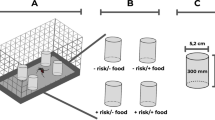Abstract
We consider a mathematical model for malaria transmission which takes into account of the increase of host’s attractiveness to mosquitoes when the host harbours the parasite’s gametocytes. We investigate how this behavioral manipulation by malaria parasite may impact the optimal interventions targeted to infectious humans like treatment and screening activities. In particular, our analysis suggests that it may produce an increase of total costs associated to the disease and its control.


Similar content being viewed by others
References
Anita, S., Arnautu, V., Capasso, V.: An Introduction to Optimal Control Problems in Life Sciences and Economics. Birkhäuser, Boston (2010)
Agusto, F.B., Tchuenche, J.M.: Control strategies for the spread of malaria in humans with variable attractiveness. Math. Popul. Stud. 20, 82–100 (2013)
Agusto, F.B., Marcus, N., Okosun, K.O.: Application of optimal control to the epidemiology of malaria. Electron. J. Differ. Equ. 2012, 1–22 (2012)
Buonomo, B.: A simple analysis of vaccination strategies for rubella. Math. Biosci. Eng. 8, 677–687 (2011)
Buonomo, B.: On the optimal vaccination strategies for horizontally and vertically transmitted infectious diseases. J. Biol. Syst. 19, 263–279 (2011)
Buonomo, B., Vargas-De-León, C.: Stability and bifurcation analysis of a vector-bias model of malaria transmission. Math. Biosci. 242, 59–67 (2013)
Chamchod, F., Britton, N.F.: Analysis of a vector-bias model on malaria transmission. Bull. Math. Biol. 73, 639–657 (2011)
Cornet, S., Nicot, A., Rivero, A., Gandon, S.: Both infected and uninfected mosquitoes are attracted toward malaria infected birds. Malar. J. 12, 179 (2013)
Cornet, S., Nicot, A., Rivero, A., Gandon, S.: Malaria infection increases bird attractiveness to uninfected mosquitoes. Ecol. Lett. 16, 323–329 (2013)
Drakeley, C., Sutherland, C., Bouserna, J.T., Sauerwein, R.W., Targett, G.A.T.: The epidemiology of plasmodium falciparum gametocytes: weapons of mass dispersion. Trends Parasitol. 22, 424–430 (2006)
Felipe, J.A.N., Riley, E.M., Drakeley, C.J., Sutherland, C.J., Ghani, A.C.: Determination of the processes driving the aquisition of immunity to malaria using a mathematical transmission. PLoS Comput. Biol. 3, e255 (2007)
Garba, S.M., Gumel, A.B., Abu Bakar, M.R.: Backward bifurcations in dengue transmission dynamics. Math. Biosci. 215, 11–25 (2008)
Gupta, S., Swinton, J., Anderson, R.M.: Theoretical studies of the effects of heterogeneity in the parasite population on the transmission dynamics of malaria. Proc. R. Soc. Lond. B, Biol. Sci. 256, 231–238 (1994)
Kingsolver, J.G.: Mosquito host choice and the epidemiology of malaria. Am. Nat. 130, 811–827 (1987)
Kong, Q., Qiu, Z., Sang, Z., Zou, Y.: Optimal control of a vector–host epidemics model. Math. Control Relat. Fields 1, 493–508 (2011)
Jung, E., Lenhart, S., Feng, Z.: Optimal control of treatments in a two–strain tuberculosis model. Discrete Contin. Dyn. Syst., Ser. B 2, 473–482 (2002)
Lacroix, R., Mukabana, W.R., Gouagna, L.C., Koella, J.C.: Malaria infection increases attractiveness of humans to mosquitoes. PLoS Biol. 3, e298 (2005)
Lenhart, S., Workman, J.T.: Optimal Control Applied to Biological Models. Chapman & Hall/CRC Mathematical and Computational Biology Series. Chapman & Hall, Boca Raton (2007)
MATLAB. Matlab release 12. The mathworks Inc., Natich (2000)
Macdonald, G.: The Epidemiology and Control of Malaria. Oxford University Press, London (1957)
Murray, C.J.L., Rosenfeld, L.C., Lim, S.S., et al.: Global malaria mortality between 1980 and 2010: a systematic analysis. Lancet 379, 413–431 (2012)
Olayemi, I.K., Ande, A.T.: Life table analysis of anopheles gambiae (diptera: culicidae) in relation to malaria transmission. J. Vector Borne Dis. 46, 295–298 (2009)
Okosun, K.O., Ouifki, R., Marcus, N.: Optimal control analysis of a malaria disease transmission model that includes treatment and vaccination with waning immunity. Biosystems 106, 136–145 (2011)
Okosun, K.O., Makinde, O.D., Takaidza, I.: Impact of optimal control on the treatment of HIV/AIDS and screening of unaware infectives. Appl. Math. Model. 37, 3802–3820 (2013)
Ozair, M., Lashari, A.A., Jung, I.H., Okosun, K.O.: Stability analysis and optimal control of a vector–borne disease with nonlinear incidence. Discrete Dyn. Nat. Soc. 2012 (2012). Article ID 595487
Pontryagin, L.S., Boltyanskii, V.G., Gamkrelidze, R.V., Mishchenko, E.F.: The Mathematical Theory of Optimal Processes. Interscience, New York (1962)
Prosper, O., Saucedo, O., Thompson, D., Torres–Garcia, G., Wang, X., Castillo–Chavez, C.: Modeling control strategies for concurrent epidemics of seasonal and pandemic H1N1 influenza. Math. Biosci. Eng. 8, 141–170 (2011)
Sherman, I.W. (ed.): Malaria: Parasite Biology, Pathogenesis and Protection. ASM Press, Washington (1998)
Wan, H., Cui, J.: A model for the transmission of malaria. Discrete Contin. Dyn. Syst., Ser. B 11, 479–496 (2009)
Vargas–De–León, C.: Global analysis of a delayed vector-bias model for malaria transmission with incubation period in mosquitoes. Math. Biosci. Eng. 9, 165–174 (2012)
World, H.: Organization, Malaria, Fact sheet n.94, March 2013 (Accessed Jul 15, 2013). http://www.who.int/mediacentre/factsheets/fs094/en/#
Acknowledgements
We would like to thank two anonymous referees for their careful reading and valuable comments, which have led to the improvement of our original manuscript.
Author information
Authors and Affiliations
Corresponding author
Rights and permissions
About this article
Cite this article
Buonomo, B., Vargas-De-León, C. Effects of Mosquitoes Host Choice on Optimal Intervention Strategies for Malaria Control. Acta Appl Math 132, 127–138 (2014). https://doi.org/10.1007/s10440-014-9894-z
Received:
Accepted:
Published:
Issue Date:
DOI: https://doi.org/10.1007/s10440-014-9894-z



